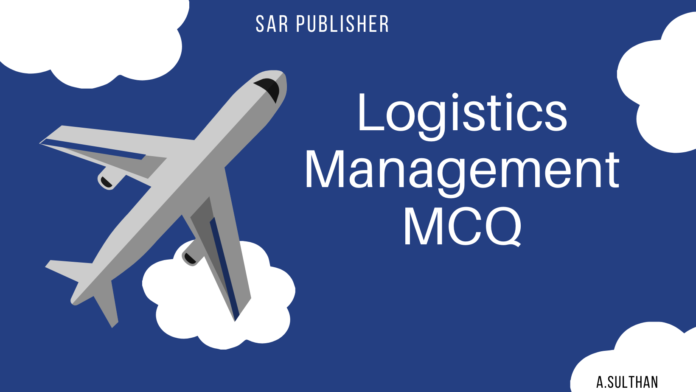Logistics Management MCQ Questions and Answers Part – 1
Logistics Management MCQ Questions and Answers Part – 2
Logistics Management MCQ Questions and Answers Part – 3
101. The warehousing function that combines the logistical flow of several small shipments to a specific market area is
A. Break bulk function.
B. Operational function.
C. Stockpiling function.
D. Consolidation function.
ANSWER: D
102. The transportation model coordinated between railways and roadways is
A. Transship.
B. Airtruck.
C. Piggyback.
D. Fishyback.
ANSWER: C
103. The transportation system that is an outcome of the combination of air and roadways is
A. Transship.
B. Airtruck.
C. Piggyback.
D. Fishyback.
ANSWER: B
104. Booking of shipping space in advance is helpful to an exporter in
A. Saving in freight charges.
B. Availing bank finance.
C. Getting priority on inland movement of cargo by all.
D. None of the above.
ANSWER: C
105. A mate’s receipt is
A. A draft bill of lading.
B. A substitute bill of lading.
C. Bill of lading evidencing goods carried on deck.
D. None of the above.
ANSWER: D
106. According to the Multimodal Transportation of Goods Act, a multimodal transport document
cannot be
A. A bearer instrument.
B. An order instrument.
C. A non-negotiable instrument.
D. None of the above.
ANSWER: D
107. The following incoterm cannot be used for contracts providing for transportation of goods by sea
A. CFR.
B. DDP.
C. DES.
D. DEQ.
ANSWER: B
108. The incoterm providing or least responsibility to seller is
A. EXW.
B. DDP.
C. FOB.
D. CIF.
ANSWER: A
109. The group of incoterms under which the seller’s responsibility is to obtain freight paid
transport document for the main carriage is
A. E terms.
B. C terms.
C. D terms.
D. F terms.
ANSWER: B
110. The price quoted by the seller for the product
A. Will vary depending upon the incoterm chosen.
B. Is irrespective of the incoterm.
C. Will be the base price.
D. None of the above.
ANSWER: A
111. Packaging performs two functions. ___________ and logistics.
A. Distribution.
B. Store keeping.
C. Material handling.
D. Marketing.
ANSWER: D
112. The outcome of the independent business function era was
A. aggressive preaching skill.
B. price -based competition.
C. customer value and harmonious relation.
D. increased productivity, profitability and market share.
ANSWER: A
113. The outcome of limited integrated business function was
A. aggressive preaching skill.
B. price based competition.
C. customer value and harmonious relation.
D. increased productivity, profitability and market share.
ANSWER: B
114. The outcome of internally integrated business function was
A. aggressive preaching skill.
B. price based competition.
C. customer value and harmonious relation.
D. increased productivity, profitability and market share.
ANSWER: C
115. The outcome of externally integrated business function was
A. aggressive preaching skill.
B. price based competition.
C. customer value and harmonious relation.
D. increased productivity, profitability and market share.
ANSWER: D
116. The period of existence of independent business function was
A. till 1950s.
B. 1960s to 1970s.
C. 1980s.
D. 1990s.
ANSWER: A
117. The non -logistical component of logistics mission
A. reflect the vision of top management.
B. deal with basic services required for delivering of goods.
C. refers to the value-added services offered.
D. reflects the ability of firm to exploit market.
ANSWER: C
118. The service mission of logistics
A. reflects the ability of firm to exploit market.ment.
B. deal with basic services required for delivering of goods.
C. refers to the value-added services offered.
D. reflect the vision of top manage
ANSWER: A
119. Marketing and sales is ___________ in the generic value chain of logistics.
A. the only activity
B. a primary activity.
C. not an activity.
D. a support activity.
ANSWER: A
120. A well defined corporate vision
A. reflects the capability of the management to think beyond the current way.
B. reflects the extent of use of logistical component for competitive advantage.
C. ensures effective implementation of logistics strategy.
D. deals with managing change.
ANSWER: A
121. The logistics strategic analysis
A. reflects the capability of the management to think beyond the current way.
B. reflects the extent of use of logistical component for competitive advantage.
C. ensures effective implementation of logistics strategy.
D. deals with managing change.
ANSWER: B
122. Vessels that carry railway passenger and freight rolling stock are
A. OBO.
B. RO/RO.
C. SD 14.
D. Train ferry.
ANSWER: D
123. Combination carrier is a unifixed cargo carrier combining container and
A. OBO.
B. RO/RO.
C. SD 14.
D. Train ferry.
ANSWER: B
124. The shipping route that lies between Western Europe, Eastern Canada and the United States is
A. The North Atlantic route.
B. The Mediterranean – Red Sea -Indian Ocean route.
C. The Cape route.
D. The South Atlantic route.
ANSWER: A
125. The sailing route that connects North Western Europe with the Eastern Europe,Southern and
Eastern Asia, Australia and New Zealand is
A. The North Atlantic route..
B. The Mediterranean -Red Sea – Indian Ocean route.
C. The Cape route.
D. The South Atlantic route.
ANSWER: B
126. The route connecting Western Europe, Africa and Australia is
A. The Cape route.
B. The South Atlantic route.
C. The Panama route.
D. The North Pacific route.
ANSWER: A
127. The route lying between South Eastern South America and North Western Europe and
Mediterranean is
A. The Cape route.
B. The South Atlantic route.
C. The Panama route.
D. The North Pacific route.
ANSWER: B
128. An advantage of a channel of distribution over selling direct to consumers is that each channel
member plays a ________ in the channel.
A. time-saving part.
B. disciplinary role.
C. specialized role.
D. informational role.
ANSWER: C
129. Historically, conventional channels have lacked the leadership to ________.
A. assign member roles and manage conflict.
B. attain efficiency and assign member roles.
C. set standard pricing and promotions.
D. set standard pricing and packaging.
ANSWER: B
130. A channel consisting of one or more independent producers, wholesalers or retailers that are seeking to maximize their own profits even at the expense of profits for the channel as a whole is a
________.
A. administered vertical marketing system.
B. conventional distribution channel.
C. vertical marketing system.
D. independent channel allocation.
ANSWER: A
131. A corporate VMS has the advantage of controlling the entire distribution chain under
________.
A. single ownership.
B. a few intermediaries.
C. little control.
D. a profit-maximizing strategic plan.
ANSWER: B
132. A distinguishing feature of a contractual VMS is that coordination and conflict management among the independent members of the channel are attained through ________.
A. working partnerships.
B. limited liability corporations.
C. natural competitive forces.
D. oral agreements.
ANSWER: A
133. ____________ is / are the basic tools for determining competitor costs.
A. Cost drivers.
B. A value chain.
C. Cost cutters.
D. A value analysis.
ANSWER: B
134. Cost efficiency is determined by which of the following drivers?
A. Supply Costs, Experience, Product/Process Design and Economies of Scale.
B. Supply Costs & Economies of Scale.
C. Product/Process Design and Economies of Scale.
D. Experience.
ANSWER: B
135. The value chain attempts to identify those activities which add value to:
A. The organisation’s stakeholders.
B. The senior strategic managers in the organization.
C. The organisation’s shareholders.
D. The customer or final user.
ANSWER: D
136. Adoption of incoterm is
A. Compulsory for all international contracts.
B. Compulsory for all letter of credit transactions.
C. Optional for the parties to the contract.
D. Mandatory for transactions with Europe.
ANSWER: C
137. Strategic stretch involves:
A. The fit between the organisation and its environment.
B. Creating new opportunities by stretching and exploiting capabilities in new ways.
C. The skills of the senior management.
D. Utilising all the resources of an organisation to their full capacity.
ANSWER: A
138. Incoterm is specific about the responsibility for marine insurance in case of
A. FOB and EXW.
B. FOB and CIF.
C. CIF and CIP.
D. CPT and DDP.
ANSWER: C
139. The price quoted by the seller for the product
A. Will vary depending upon the incoterm chosen.
B. Is irrespective of the incoterm.
C. Will be the base price.
D. None of the above.
ANSWER: A
140. The incoterm should indicate the place of shipment in case of
A. F terms.
B. E terms.
C. C terms.
D. D terms.
ANSWER: A
141. The group of terms arranged in order of increasing responsibility of exporter is
A. C,D,E and E terms.
B. D,E,F and C terms.
C. E,F,C and D terms.
D. F,C,E and D terms.
ANSWER: C
142. Incoterms cover
A. Trade in intangibles.
B. Ownership and transfer rights.
C. Contracts of carriage.
D. Rights and obligations of parties to contract of sales.
ANSWER: D
143. Airway bill is prepared in
A. three originals.
B. Quadruplicate.
C. As many copies as required.
D. One original only.
ANSWER: A
144. The following transport document is acceptable under a letter of credit
A. House airway bill.
B. House bill of lading.
C. Warehouse receipt.
D. Tramp bill of lading.
ANSWER: A
145. Freight to pay bill of lading is acceptable if
A. The contract term is CIF.
B. The contract term is CFR.
C. The contract term is FOB.
D. Goods are carried by a foreign vessel.
ANSWER: C
146. A transferable credit can be transferred
A. Once.
B. Twice.
C. Thrice.
D. Any number of times.
ANSWER: A
147. When goods are sent to an agent of an exporter in the importing country, the method of payment adopted is
A. Open account.
B. Letter of credit.
C. Consignment sale.
D. Document against acceptance.
ANSWER: C
148. The best form of method of payment for an importer would be
A. Advance remittance.
B. Letter of credit.
C. Documents against payment.
D. Open account.
ANSWER: D
149. The internal process leads to
A. Supply uncertainty.
B. Process uncertainty.
C. Demand uncertainty.
D. Production uncertainty.
ANSWER: B
150. The flow of information that facilitates operational activities is
A. Forward information flow.
B. Backward information flow.
C. Upward information flow.
D. Downward information flow.
ANSWER: A


